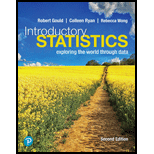
Peanut Allergies In a 2015 study reported in the New England Journal of Medicine, Du Toit et al. randomly assigned infants who were likely to develop a peanut allergy (as measured by having eczema, egg allergies, or both) to either consume or avoid peanuts until 60 months of age. The infants in this cohort did not previously show any preexisting sensitivity to peanut extract. The numbers in each group developing a peanut allergy by 60 months of age are shown in the following table.

a. Compare the percentages in each group that developed a peanut allergy by age 60 months.
b. Test the hypothesis that treatment group and peanut allergy are associated using the chi-square statistic. Use a significance level of
c. Do a Fisher’s Exact Test for the data with the same significance level. Report the two-tailed
d. Compare the
c. Which is more accurate? Explain.
Want to see the full answer?
Check out a sample textbook solution
Chapter 10 Solutions
INTRODUCTORY STATISTICS (LOOSELEAF)
 Glencoe Algebra 1, Student Edition, 9780079039897...AlgebraISBN:9780079039897Author:CarterPublisher:McGraw Hill
Glencoe Algebra 1, Student Edition, 9780079039897...AlgebraISBN:9780079039897Author:CarterPublisher:McGraw Hill Holt Mcdougal Larson Pre-algebra: Student Edition...AlgebraISBN:9780547587776Author:HOLT MCDOUGALPublisher:HOLT MCDOUGAL
Holt Mcdougal Larson Pre-algebra: Student Edition...AlgebraISBN:9780547587776Author:HOLT MCDOUGALPublisher:HOLT MCDOUGAL College Algebra (MindTap Course List)AlgebraISBN:9781305652231Author:R. David Gustafson, Jeff HughesPublisher:Cengage Learning
College Algebra (MindTap Course List)AlgebraISBN:9781305652231Author:R. David Gustafson, Jeff HughesPublisher:Cengage Learning Big Ideas Math A Bridge To Success Algebra 1: Stu...AlgebraISBN:9781680331141Author:HOUGHTON MIFFLIN HARCOURTPublisher:Houghton Mifflin Harcourt
Big Ideas Math A Bridge To Success Algebra 1: Stu...AlgebraISBN:9781680331141Author:HOUGHTON MIFFLIN HARCOURTPublisher:Houghton Mifflin Harcourt




